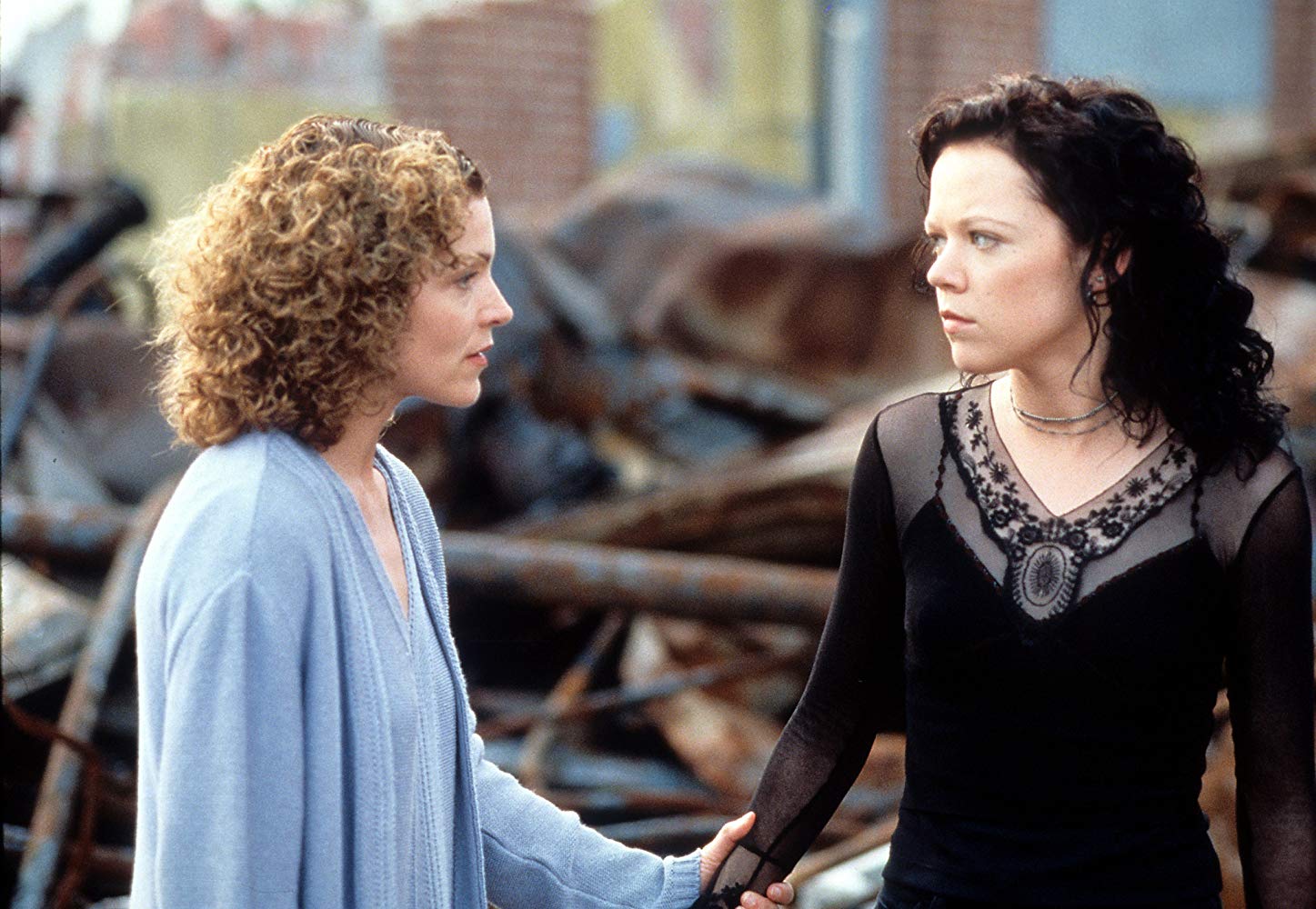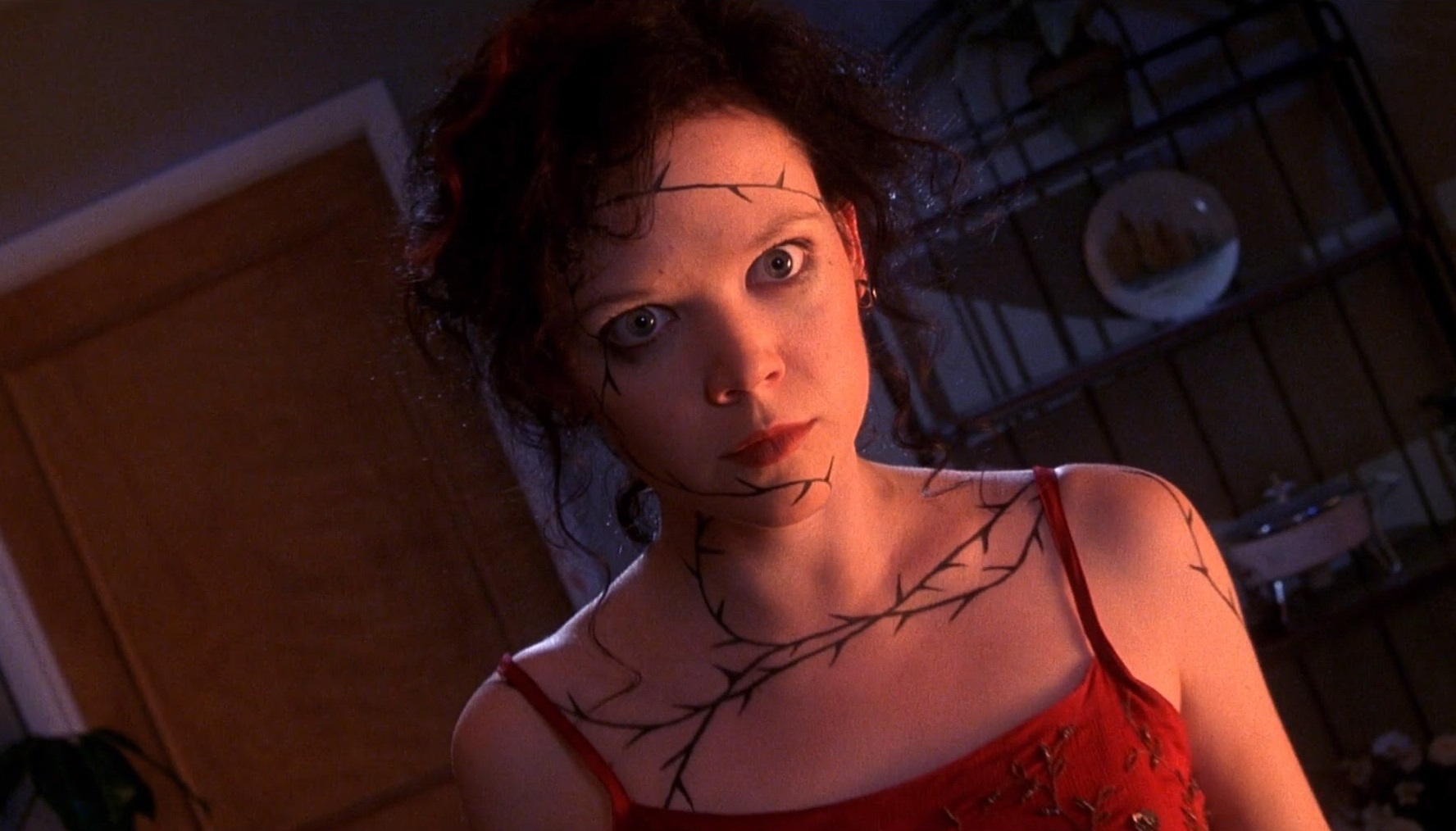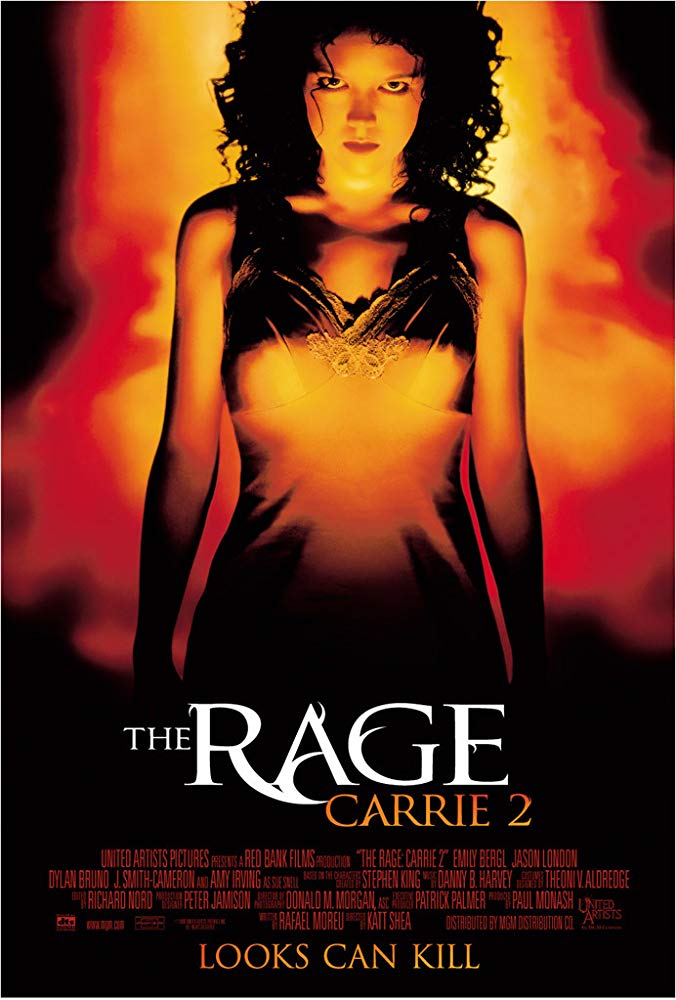Crew
Director – Katt Shea, Screenplay – Rafael Moreu, Producer – Paul Monash, Photography (colour + some scenes b&w) – Donald M. Morgan, Music – Danny B. Harvey, Music Supervisors – George Ghiz & Richard Winn, Visual Effects Supervisor – Stuart Robertson, Digital Visual Effects – Kleiser-Walczak Construction Co (Supervisor – Frank E. Vitz), Special Effects Supervisor – Roy H. Arbogast, Makeup Effects – Tom Burman & Bari Dreiband-Burman, Production Design – Peter Jamison. Production Company – United Artists/Red Bank Films.
Cast
Emily Bergl (Rachel Lang), Jason London (Jesse Ryan), Dylan Bruno (Mark Bing), Amy Irving (Sue Snell), Zachery Ty Bryan (Eric Stark), Rachel Blanchard (Monica Jones), J. Smith-Cameron (Barbara Lang), Charlotte Lopez (Tracy Campbell), Mena Suvari (Lisa Parker), John Doe (Boyd), Kate Skinner (Emilyn)
Plot
Sixteen year-old Rachel Lang is upset when her best friend Lisa jumps off the school roof after learning that the football jock Eric Stark that she gave her virginity to only did it as part of a game among the jock fraternity that awards points dependant on which girl one scores with. However, Lisa has left Rachel a set of photos that proves she was with Eric, which would be enough to charge him with statutory rape. The jock fraternity try to scare Rachel into not talking. At the same time, handsome and sensitive jock Jesse Ryan becomes interested in Rachel, who is regarded as a dog by the other jocks, and the two become lovers. At a party, the jocks pull a cruel prank on Rachel, revealing they were videotaping her and Jesse having sex and tell her it was part of the points game. However, they have reckoned without Rachel’s telekinetic abilities, which now suddenly erupt in revenge.
Brian De Palma’s film adaptation of Stephen King’s Carrie (1976) was a standout classic. De Palma launched into Stephen King’s novel with a bravura directorial excess, inflating the religious themes into torrid melodrama, while showering the film with dressy attention-grabbing stylistic flourishes. Added together with a great cast, Carrie was the only horror film since The Exorcist (1973) and until The Silence of the Lambs (1991) to have two of its cast nominated for Academy Awards – it became an influential hit that inspired its a mini-cycle of telekinetic revenge dramas. It could even be argued that it was the success of Carrie that drew public attention to Stephen King’s name – both the book releases of Salem’s Lot (1975) and The Shining (1977) made great mention of “Stephen King, author of the film Carrie” – and helped him go on to become the best-selling author that he is today.
Anything with Stephen King’s name attached to it seems to attract filmmakers. Lesser works have been spun out to endless lengths – Children of the Corn (1984), one of the worst King films, has had eight sequels and a remake made from it; the tepid tv movie Sometimes They Come Back (1991) has had two made-for-video sequels; and all of Creepshow (1982), Pet Sematary (1989) and The Lawnmower Man (1992) have had sequels; Salem’s Lot (1979), The Shining (1980), The Dead Zone (1983) and Maximum Overdrive (1986) have both been through remakes, while Carrie later underwent a remake as the tv mini-series Carrie (2002) and a theatrical film Carrie (2013).
The Rage: Carrie 2 is sequelaic exploitation of the worst order. There is no connection between it and Carrie. The sequel tries to justify the connection with some talk of the two telekinetic teens both having the same father. It also brings back Amy Irving’s character – the good girl among the tormentors in the original, now a school counsellor who, less than believably, is haunted by what happened every time she sees something fall off a table without apparent cause. (Amy Irving’s character has little point in the film – she seems to be the only one who knows what is going on but at the climax is casually swept aside with a poker psychically impaled through the head).

The Rage: Carrie 2 tries to tell a similar story to the original – another teenager who is regarded as a geek and treated cruelly by her peers (a group of football jocks in this film as opposed to bitchy girls), becomes involved with a cool guy who goes beneath his social station to date her, and a climax where the teenage girl explodes in telekinetic revenge after a cruel prank is played on her at a party. Carrie 2 also copies the first film’s nightmare twist ending.
To give it its due, The Rage: Carrie 2 seems to be making an effort to be similar but not identical. The relationship with the guy who asks the girl out is much more central to the story – indeed, this film’s Carrie actually ends up losing her virginity. This story is notedly missing the abusive family background element that added a big kick to the original – there is a foster family she stays with who seem to treat her badly but this is a minor element and hardly anything on the order of the alarming child abuse that took place in the first film. Where the sequel becomes interesting is in its starting to suggest a Carrie updated for the 1990s where the teen geek dresses Goth and joins the body-illustrating generation with a tattoo. The Carrie character here is certainly a lot cooler and socially astute than Sissy Spacek was in the first film.
That is also a considerable part of the problem with the film. In updating the character, the film feels stretched in trying to make a case for the Carrie character here as an abused innocent whose eruption of psychic violence is just revenge against an unbearably cruel world. Emily Bergl’s Carrie seems just too aware. In the original film, Sissy Spacek gave an extraordinary performance that started deep inside and suggested someone who really had lived their entire life as a dominated mouse. She even had the physical looks to suggest a Cinderella-transformation from mouse to prom queen. Here Emily Bergl has none of that – she is too well dressed and too good-looking, more like she has stepped off the set of Dawson’s Creek (1998-2003), and suggests nothing of a social reject or a geek. Indeed, Emily Bergl makes one wonder what it is that the bullies fail to see in her such that they regard her and her friend as social undesirables.
Moreover, the big prank that is played on Emily Bergl and her friend – high-school jocks having a rating system for each girl they can score with and then dumping them straight after – seems monumentally underwhelming. When statistics reveal that most American teens are losing their virginity by the age of thirteen, it seems hard to join in the film’s desire to find that teens are having underage sex outrageous, let alone it getting scandalised about the fact that some jocks fuck and then dump girls. When the Carrie character erupts in psychic revenge, it seems a vast overreaction to a not particularly nice but surely at most a somewhat upsetting situation. There is none of the sense of cruelty that existed in the first film’s locker-room pranks, nor does The Rage: Carrie 2 engender the sense of outrage at the way Carrie is abused by her religiously domineering mother, such that the character’s psychic revenge becomes a primal scream against an unjust universe the way it did in the first Carrie.

The Rage: Carrie 2 is directed by Katt Shea, who before her divorce used to be credited as Katt Shea Ruben. Katt Shea started work as an actress under Roger Corman and went onto direct films like Stripped to Kill (1987), Dance of the Damned (1989), Streets (1990) and Poison Ivy (1992). An arguable feminist agenda runs through Katt Shea’s films. All her films have female protagonists and both the Stripped to Kill films and Streets show a concern for women who live outside of the mainstream of society. Equally, one could argue that Katt Shea’s films have a conservative agenda. Streets holds up returning to a sentimental version of family life as a desirable ideal; while Poison Ivy does the conservative family values thing a la Fatal Attraction (1987) in depicting a girl who embodies the values of a loose teenager as a dangerous influence that is morally corrupting a standard American nuclear family. It is hard to see where The Rage: Carrie 2 sits amidst Katt Shea’s oeuvre – certainly there is the element of a woman standing up for revenge – but one suspects that this is more a case of Shea having been handed a commercial product than any particular thematic concerns.
One thing is certain – that The Rage: Carrie 2 is Katt Shea’s worst film. In Carrie, Brian De Palma tricked the show out like a gorgeous film-school exercise in all the possibilities a camera could be put to – split screen, slow-motion, 360 degree tracking shots, even tableaux modelled after the Crucifixion and the Last Supper; in The Rage: Carrie 2, Katt Shea’s idea of style by comparison is to cut to black-and-white film stock and shake the camera about every time Emily Bergl has a psychic outbreak. One gets the impression that Katt Shea was not interested in making a film about psychic powers. She seems more interested in the burgeoning romance between Emily Bergl and Jason London than in building the psychic element up – the climax almost emerges as an afterthought.
And when the climax does come, it is a complete disaster. It seems to have been grafted on from another film altogether – something like a campy late 1980s A Nightmare on Elm Street (1984) imitator. The scenes with pokers flying through the air to impale not one but two people on either side of a door through the head, of people being sliced to death by spinning cd’s, even attacked by a psychically animated automatic pool cover are ridiculous. For some reason, the effect of Emily Bergl’s psychic rage building up is denoted by the thorns of her rose tattoo spreading over her body and face – what it means is anybody’s guess, but the effect is utterly silly. Similarly, the casual killing off of Emily Bergl by a falling corner of the house roof just as she goes to embrace Jason London is laughable in the melodramatic happy wrap-up ending contrivance.
(Winner in this site’s Worst Films of 1999 list).
Trailer here


